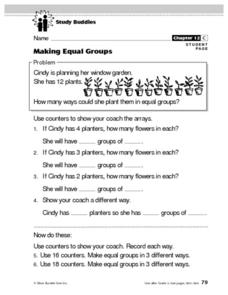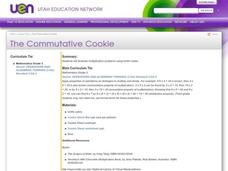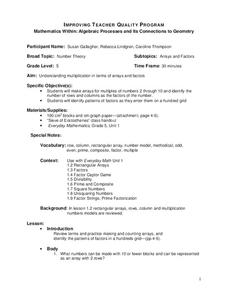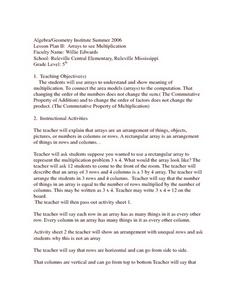Curated OER
Making Equal Groups
In this making equal groups worksheet, students, working with a partner, study and calculate how to make equal groups through six word problems.
Curated OER
Multiplying by Two-Digit Numbers
In this mathematics worksheet, 6th graders find the product of a given equation. Then they use an array and find the sum of the partial products. Students also use zeros as place holders when necessary.
Curated OER
Multiplying Decimals
In this mathematics worksheet, 6th graders estimate the product and use an array to help them find the product. Then they find the exact product and locate where to put the decimal point in each.
Curated OER
Multiplication As An Array
In this multiplication as an array worksheet, students, after being shown two prime examples, fill in the missing parts, ten blanks, of two equations that illustrate multiplication as an array.
Curated OER
Arrays
In this math worksheet, students examine 12 arrays and write the multiplication problem that corresponds with the picture. There are no examples.
Curated OER
Variable Arrays
Twelfth graders compare and contrast variables and arrays. Using data, they enter the information into a spreadsheet and an array to compare how they appear. To end the lesson, they complete basic programs in which they use arrays.
Curated OER
Square Numbers
Fourth graders demonstrate multiple ways to represent whole numbers, decimals, and fractions. Through demonstration and hands-on activities they model square numbers using arrays. Students visually determine that the array makes a square.
Curated OER
The Commutative Cookie
Third graders investigate the commutative properties of multiplication and focus upon the setting of cubes in the correct patterns to solve problems. They differentiate between numbers that have multiple factors and prime numbers....
Curated OER
The Difference of Two Squares
Students practice the use of number properties through exploring the difference of two squares, creating an array model for multiplication, and work with decimal numbers. In groups, students explore patterns in an array and determine...
Curated OER
Mathematics Within: Algebraic Processes and Its Connections to Geometry
Fifth graders discover the connections between algebra and geometry. With a focus on arrays and factors, they are introduced to multiplication. They develop an array for multiples of 2 through 10 and identify the factors of each row....
Curated OER
Arrays And Factors
Students participate in a lesson plan that is concerned with the concepts of arrays and factors. They use a Hershey bar and divide it into segments in order to simulate the arrays. Then students construct other arrays from the leftover...
Curated OER
Arrays To See Multiplication
Fifth graders examine multiplication. They construct arrays to demonstrate specific multiplication facts. They identify examples and non-examples of arrays. Students use counters to model the commutative property of multiplication.
Curated OER
Prime and Composite Numbers
Fifth graders use prime factorization to identify prime and composite numbers. They use cubes to find factors. In groups, 5th graders draw rectangular arrays to discover prime numbers under 100.
Curated OER
Working with larger arrays
Fifth graders use arrays to show the meaning of multipication in selected situations. They practice using large and small arrays. The lesson has numerous activities, which gives students more opportunities to display academic growth.
Curated OER
Introduction to Estimation and Making Arrays
Students explore the concept of estimating and organizing a group of objects into an array to count the exact number of items. They create their own arrays and practice elements of estimation.
Curated OER
"Study Finds Soft Drink Consumption Up, Health Down"
Students compare the nutrients in soda with those in milk after reading an online article. They identify micronutrients that are important in the teen years and those that help stave off disease.
Curated OER
Multiplication and Division with Arrays
Students practice the commutative property, create and manipulate arrays and multiply and divide numbers.
Curated OER
Arrays
In this arrays worksheet, students analyze 10 arrays. There are no directions on the page, but it is assumed that students would write the multiplication fact that matches each array.
Curated OER
Little Magic Squares
Students and teacher talk about arrays of numbers like the ones in A Square of Circles. They check to see that the rows all have the same sum; that the columns all have the same sum; and that the diagonals have the same sum.
Curated OER
Hooked On Problem Solving
Fourth graders use properties of operations and problem-solving strategies to do mental calculations, and look for patterns in the solutions. They create an array, using each of the digits 1-9 exactly once to form addition problems...
Curated OER
students rotate through four workstations that reinforce the concept of symmetry
Second graders, in pairs, use arrays to explore the relationship between multiplication and division.
Curated OER
The Commutative Property
Students explore arrays. They get into pairs and receive bags of small buttons to each group.
Curated OER
Array to Go!
Second graders are introduced to arrays as a means for multiplication readiness. Once students are comfortable with naming the array by counting the columns and rows, they integrate skip counting.
Other
Programming Simplified: Java Programs
See some examples made for beginning programmers to understand how to use java to write simple Java programs. These codes demonstrate how to get input from user, working with loops, strings and arrays.

























